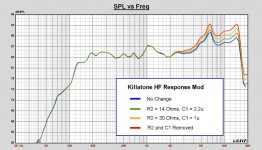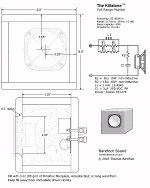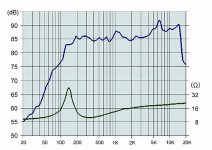What does a Auratone 5C sound like?
I heard it was a Pioneer 4.5" driver but its not made anymore.
What driver is a good replacement?
This was a recording studio speaker that is suppose to suck but sound like common car stereos and ghetto blasters of the time.
I heard it was a Pioneer 4.5" driver but its not made anymore.
What driver is a good replacement?
This was a recording studio speaker that is suppose to suck but sound like common car stereos and ghetto blasters of the time.
I've built one like described here:
Auratone DIY
With this cheap Maplin speaker 51/4? 60W Shielded Bass/Mid Woofer : Hi-Fi Speakers : Maplin Electronics
Sounded ok for its purpose.
Auratone DIY
With this cheap Maplin speaker 51/4? 60W Shielded Bass/Mid Woofer : Hi-Fi Speakers : Maplin Electronics
Sounded ok for its purpose.
Last edited:
This is my version of the auraclones. They have a nice and clear midrange.
An externally hosted image should be here but it was not working when we last tested it.
I wonder if Dayton PA130-8 can work well here. It's a nice full range and probably perfect for 100Hz to 10k in a small sealed box.
Killatone
Here you have plans to make a good copy of it... made by John Slayers' :John Sayers' Recording Studio Design Forum • View topic - The Killatone DIY speaker project
You have to register to see the pictures. Verry neat! Made by Barefoot Sound!
😉
Here you have plans to make a good copy of it... made by John Slayers' :John Sayers' Recording Studio Design Forum • View topic - The Killatone DIY speaker project
You have to register to see the pictures. Verry neat! Made by Barefoot Sound!
😉
Google images is your friend. The Fostex FE127E or F120FX all will have a significant rising response that I think will bite your ears off.
Look at the response on this graph +9dB rise from 2k to 7k of shout.
No thanks. I thought there was a compensation circuit?
Look at the response on this graph +9dB rise from 2k to 7k of shout.
No thanks. I thought there was a compensation circuit?
Attachments
Last edited:
Yes See in the previous post in the same thread: The "crossover" consists of a parallel impedance compensation network (R2, C1) along with a baffle step compensation filter (R1, L1).
First post: John Sayers' Recording Studio Design Forum • View topic - The Killatone DIY speaker project)
First post: John Sayers' Recording Studio Design Forum • View topic - The Killatone DIY speaker project)
The curve above includes the compensation which took it down a few dB. Still there though.
By contrast I think this response is a lot more pleasant.
http://www.parts-express.com/pedocs/specs/295-010-dayton-audio-pa130-8-specifications-46131.pdf
By contrast I think this response is a lot more pleasant.
http://www.parts-express.com/pedocs/specs/295-010-dayton-audio-pa130-8-specifications-46131.pdf
Last edited:
Thanks for reposting plans. The BSC looks about right and I think you can use a notch at 7k to tame that peak.
Nice looking box though.
Nice looking box though.
This is my version of the auraclones. They have a nice and clear midrange.
An externally hosted image should be here but it was not working when we last tested it.
Your picture is on the other side of your log-in so we can't see it.
dave
Shure the purpose of the Auratones were used to concentrate on low-mid and mids to check compatibility with tv/cars's speakers. They weren't flat for but I think that this Diy is in the same intent...
This is what Thomas Barefoot said:
" Here it is, by popular demand, the first Do-It-Yourself project for the Speaking of Speakers forum!
This first project is called the Killatone(TM). It's an updated version of the once popular Auratone 5C "full range" monitor.
Design overview:
The Killatone is an inexpensive, easy to build, single driver, closed-box loudspeaker intended for use as a limited bandwidth reference monitor for recording. It uses the 5" Fostex FE127E magnetically shielded driver in a 3.6 liter sealed cabinet to achieve a low frequency -3 dB cutoff of 117 Hz. The "crossover" consists of a parallel impedance compensation network (R2, C1) along with a baffle step compensation filter (R1, L1).
A completed pair should cost about $130 US.
Construction:
The prototype was constructed of 0.75" MDF in accordance with the diagram below. The driver was offset from the center of the baffle and the cabinet corners were rounded over in order to minimize response ripples induced by edge diffraction. The inner driver opening was also rounded over to minimize air turbulence noise as well as to reduce standing waves that often occur in this vicinity. However, the construction method and materials are widely open to experimentation. The only critical dimensions of the cabinet are as follows:
Don't change these:
1. The internal volume - in order to maintain the correct low frequency cutoff and damping characteristics.
2. The front baffle dimensions - the baffle step compensation filter is designed to compensate specifically for the response shelf which occurs due to an 8" wide baffle.
3. The amount of fill - this helps achieve the proper low end alignment as well as reduces internal cabinet resonances. Even here the exact amount of fill is not critical, but you should try to get it approximately right.
Otherwise, build it as you like. 🙂 "
This is what Thomas Barefoot said:
" Here it is, by popular demand, the first Do-It-Yourself project for the Speaking of Speakers forum!
This first project is called the Killatone(TM). It's an updated version of the once popular Auratone 5C "full range" monitor.
Design overview:
The Killatone is an inexpensive, easy to build, single driver, closed-box loudspeaker intended for use as a limited bandwidth reference monitor for recording. It uses the 5" Fostex FE127E magnetically shielded driver in a 3.6 liter sealed cabinet to achieve a low frequency -3 dB cutoff of 117 Hz. The "crossover" consists of a parallel impedance compensation network (R2, C1) along with a baffle step compensation filter (R1, L1).
A completed pair should cost about $130 US.
Construction:
The prototype was constructed of 0.75" MDF in accordance with the diagram below. The driver was offset from the center of the baffle and the cabinet corners were rounded over in order to minimize response ripples induced by edge diffraction. The inner driver opening was also rounded over to minimize air turbulence noise as well as to reduce standing waves that often occur in this vicinity. However, the construction method and materials are widely open to experimentation. The only critical dimensions of the cabinet are as follows:
Don't change these:
1. The internal volume - in order to maintain the correct low frequency cutoff and damping characteristics.
2. The front baffle dimensions - the baffle step compensation filter is designed to compensate specifically for the response shelf which occurs due to an 8" wide baffle.
3. The amount of fill - this helps achieve the proper low end alignment as well as reduces internal cabinet resonances. Even here the exact amount of fill is not critical, but you should try to get it approximately right.
Otherwise, build it as you like. 🙂 "
]The Fostex FE127E or F120FX all will have a significant rising response that I think will bite your ears off.
FE127e (good luck finding any) do have some (mostly fixable) HF issues, The FX120 not so much.

dave
You can visit the Barefoot's website to see what he produces as studio monitors here: Barefoot Sound
Why! The horror tones were terrible sounding. Like the factory mono dash speaker of a 1978 chevy or the single speaker in a 20" tv of the same era. If this is what you want to listen to go ahead and build a pair of anal tones.
We built something along these lines (a bit bigger at ~9 litre) for the Alpair 10.2eN (for use in one of my workspaces). Butterworth Q, F3 72Hz. Haven't taken pictures yet.
dave
dave
In fairness, I think some context is worth keeping in mind, viz. that not everybody listens at 1m on-axis, nor is every loudspeaker designed to be listened to in such a position. Lynn Olson frequently notes his preference (which I share) for designing multiway speaker XOs based on 2m (or greater, for large speakers) distances for better / more representative summing. This is actually mentioned in the 2nd post of the linked thread:
The vast majority of wideband drivers tend to have a rising on-axis response. This is not because their designers are incompetent; it is generally because they are not intended to be listened to at 1m on-axis, and because of the poor dispersion of most cones over about 2in (especially with deep profiles) they've kicked the top end up so it holds up better off-axis and thus has a wider useful listening window. The PA-130 (a decent unit) is OK for instance out to about 11KHz 15 degrees off, but falls off quite quickly as you move further out. So I would be somewhat hesitant about making value judgements on the performance of any speaker based purely on its 1m on-axis response behaviour. Particularly for those not designed to be used under such conditions. Granted, not everybody agrees with this design approach -but like anything else, it's about selecting the compromises that best suit the design goals. YMMV.
The LEAP measures above indicate a couple of modes that would be worth addressing (separate from the general rising response trend); they should be fairly easy to kill with some judicious mechanical damping. From the look of them, they're of the old FE127E (consistent with other measures), which as Dave notes did have some generally fixable issues. The FX120 had slightly different goals and was designed for a different market (it was about 5x the cost of the contemporary E series models & aimed less at home audio than for small Japanese studios).
The high frequency bumps turn out to be rather inconsequential because you literally need to be dead on axis with the driver to hear them. The 5" driver focuses those frequencies so narrowly that, unless your head is clamped on axis in a vise [sic], the highs are actually rather subdued in most listening positions. And without the distraction of the deep bass you're essentially forced to concentrate on the midbass and midrange.
The vast majority of wideband drivers tend to have a rising on-axis response. This is not because their designers are incompetent; it is generally because they are not intended to be listened to at 1m on-axis, and because of the poor dispersion of most cones over about 2in (especially with deep profiles) they've kicked the top end up so it holds up better off-axis and thus has a wider useful listening window. The PA-130 (a decent unit) is OK for instance out to about 11KHz 15 degrees off, but falls off quite quickly as you move further out. So I would be somewhat hesitant about making value judgements on the performance of any speaker based purely on its 1m on-axis response behaviour. Particularly for those not designed to be used under such conditions. Granted, not everybody agrees with this design approach -but like anything else, it's about selecting the compromises that best suit the design goals. YMMV.
The LEAP measures above indicate a couple of modes that would be worth addressing (separate from the general rising response trend); they should be fairly easy to kill with some judicious mechanical damping. From the look of them, they're of the old FE127E (consistent with other measures), which as Dave notes did have some generally fixable issues. The FX120 had slightly different goals and was designed for a different market (it was about 5x the cost of the contemporary E series models & aimed less at home audio than for small Japanese studios).
Last edited:
Why! The horror tones were terrible sounding. Like the factory mono dash speaker of a 1978 chevy or the single speaker in a 20" tv of the same era. If this is what you want to listen to go ahead and build a pair of anal tones.
Read the first post ant the replies. 😉 This is in context (Auratone 5C) that the author of this subject was asking to make the best copy of the original.
My two cents 😉
- Home
- Loudspeakers
- Full Range
- Auratone 5C Clone?



